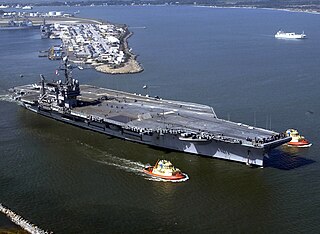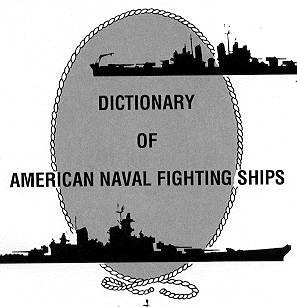
USS John F. Kennedy (CV-67) is the only ship of her class and the last conventionally powered carrier built for the United States Navy. The ship is named after the 35th President of the United States, John F. Kennedy, and is nicknamed "Big John." Kennedy was originally designated a CVA ; however, the designation was changed to CV to denote that the ship was capable of anti-submarine warfare, making her an all-purpose carrier.
Four ships of the United States Navy have borne the name USS Sterett in honor of Master Commandant Andrew Sterett (1778–1807), who served during the Quasi-War with France and the Barbary Wars.

Bath Iron Works (BIW) is a major United States shipyard located on the Kennebec River in Bath, Maine, founded in 1884 as Bath Iron Works, Limited. BIW has built private, commercial, and military vessels, most of which have been ordered by the United States Navy. The shipyard has built and sometimes designed battleships, frigates, cruisers, and destroyers, including the Arleigh Burke class which are currently among the world's most advanced surface warships.

USS Claude V. Ricketts (DDG-5), previously Biddle and DD-955, was a Charles F. Adams-class guided missile destroyer of the United States Navy. She was the third US Naval ship named after Nicholas Biddle, one of the first five captains of the Continental Navy.

USS Bordelon (DD/DDR-881) was one of 98 World War II Gearing-class destroyers of the United States Navy, and was named for Marine Staff Sergeant William J. Bordelon (1920–1943), who was posthumously awarded the Medal of Honor for his heroism in the Battle of Tarawa.
Three ships in the United States Navy have been named USS Jouett for James Edward Jouett.

The California class of cruisers were a set of two nuclear-powered guided missile cruisers operated by the United States Navy between 1974 and 1998. Other than their nuclear power supply and lack of helicopter hangars, ships of the California class were comparable to other guided missile cruisers of their era, such as the Belknap class. The class was built as a follow-up to the nuclear-powered Long Beach, Bainbridge, and Truxtun classes. Like all of the nuclear cruisers, which could steam for years between refuelings, the California class was designed in part to provide high endurance escort for the navy's nuclear aircraft carriers, which were often limited in range due to their conventionally powered escorts continuously needing to be refueled.

USS Fox (DLG-33/CG-33) was a Belknap class cruiser of the United States Navy, named after Gustavus V. Fox, President Abraham Lincoln's Assistant Secretary of the Navy. The keel for DLG-33 was authenticated and laid in ceremonies at Todd Shipyards, Los Angeles Division, San Pedro, California on 15 January 1963.

USS Jouett (DLG-29) was a Belknap-class cruiser laid down 25 September 1962 by Puget Sound Naval Shipyard, Bremerton, Washington; launched 30 June 1964; sponsored by Mrs. S. J. Ervin, Jr., wife of the Senator from North Carolina; and commissioned 3 December 1966, Captain Robert S. Hayes in command. She was named after RADM James Edward Jouett

The Belknap-class cruiser was a class of single-ended guided missile cruisers built for the United States Navy during the 1960s. They were originally designated as DLG frigates, but in the 1975 fleet realignment, they were reclassified as guided missile cruisers (CG).

Leahy-class cruisers were a class of guided missile cruisers built for the United States Navy. They were originally designated as Destroyer Leaders (DLG), but in the 1975 cruiser realignment they were reclassified as guided missile cruisers (CG).

USS Horne (DLG/CG-30) was a Belknap-class destroyer leader/cruiser, named for Admiral Frederick J. Horne, 1880–1959. She was launched as DLG-30, a destroyer, and reclassified a cruiser on 30 June 1975.

Flush deck is a term in naval architecture. It can refer to any deck of a ship which is continuous from stem to stern. It has two specific common referents:

The RIM-67 Standard ER (SM-1ER/SM-2ER) is an extended range surface-to-air missile (SAM) and anti ship missile originally developed for the United States Navy (USN). The RIM-67 was developed as a replacement for the RIM-8 Talos, a 1950s system deployed on a variety of USN ships, and eventually replaced the RIM-2 Terrier as well, since it was of a similar size and fitted existing Terrier launchers and magazines. The RIM-66 Standard MR was essentially the same missile without the booster stage, designed to replace the RIM-24 Tartar. The RIM-66/67 series thus became the US Navy's universal SAM system, hence the "Standard Missile" moniker.

The AN/SPS-40 is a United States Navy two-dimensional, long range air search radar that is capable of providing contact bearing and range. It was used on Perth-class destroyers, Forrest Sherman-class destroyers, Charles F. Adams-class destroyers, Spruance-class destroyers, Belknap-class cruisers, Leahy-class cruisers, Knox-class frigates, Bronstein-class frigates, Hamilton-class cutters, Raleigh-class amphibious transport docks and many other ship classes. Its "basket" antenna with the over-the-top feed line was a familiar sight throughout the Navy even into the late 1980s. It was replaced by the AN/SPS-49 on newer ships and on ships that received the New Threat Upgrade.

Rear Admiral Reginald Rowan Belknap was an officer in the United States Navy. He served in the Spanish–American War, Boxer Rebellion, Philippine–American War, and World War I. He gained distinction in 1909 for his relief work in Italy after the 1908 Messina earthquake and tsunami and for his work in command of the first offensive mining campaign in U.S. Navy history, the laying of the North Sea Mine Barrage in 1918. He was also a published author, an inventor, a member of many professional and social organizations, and an active member of the Episcopal Church, and he played a role in the selection of Amelia Earhart as the first female pilot to make a solo flight across the Atlantic Ocean.

Lieutenant Commander Charles K. Belknap Jr. was the commander of the USS Ammen (DD-35) in 1913. He was the censor for the United States Navy in 1917.



















